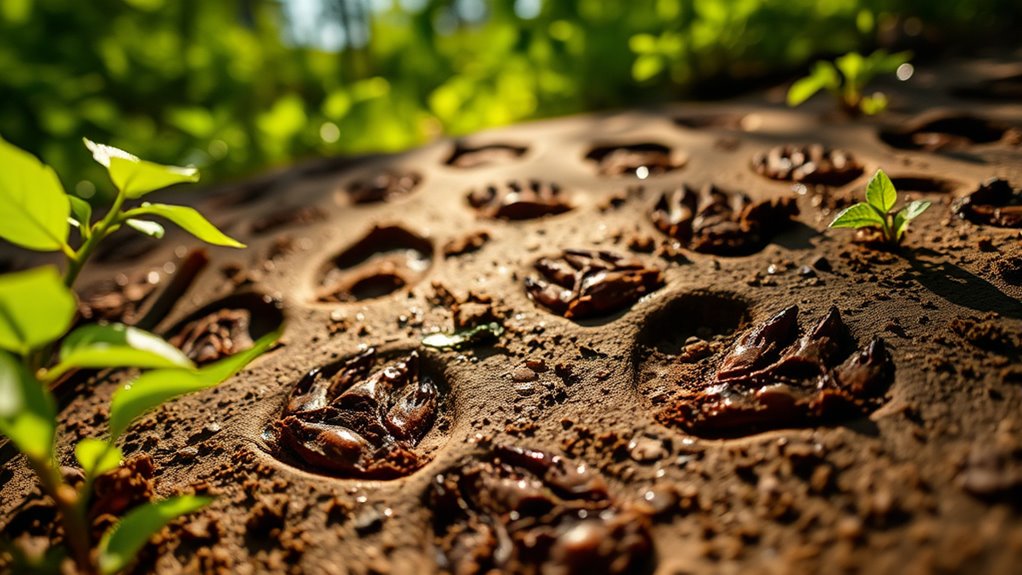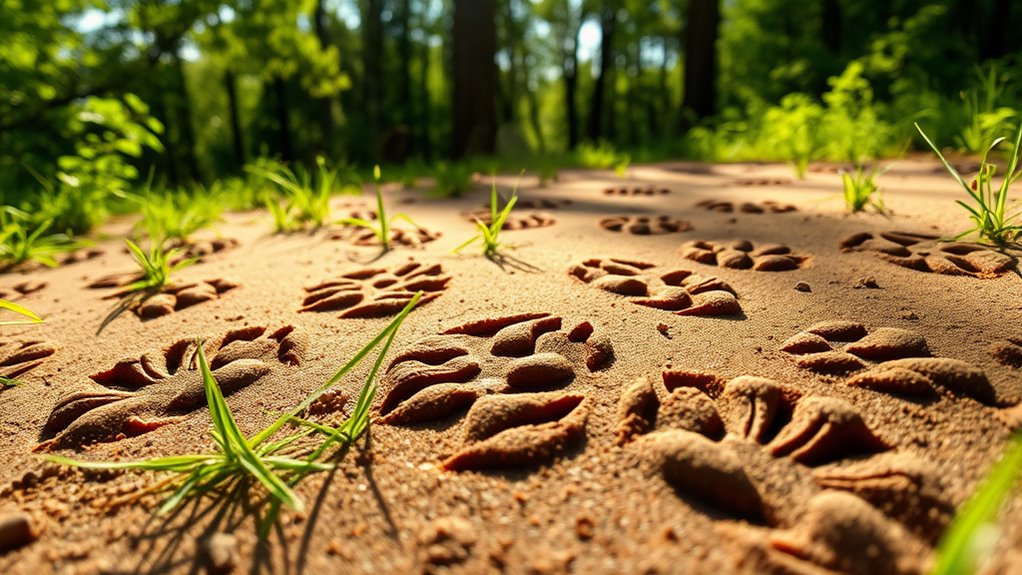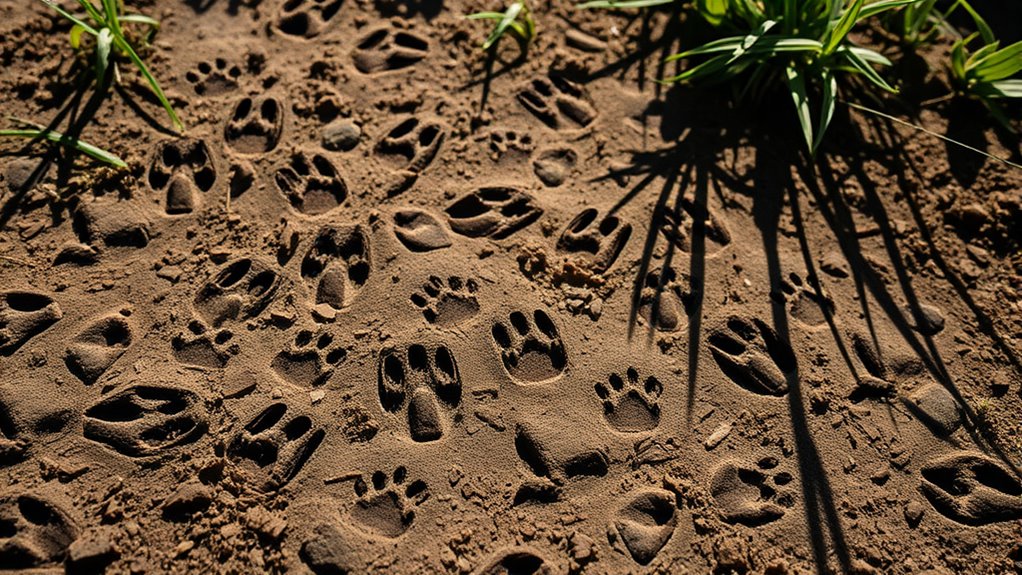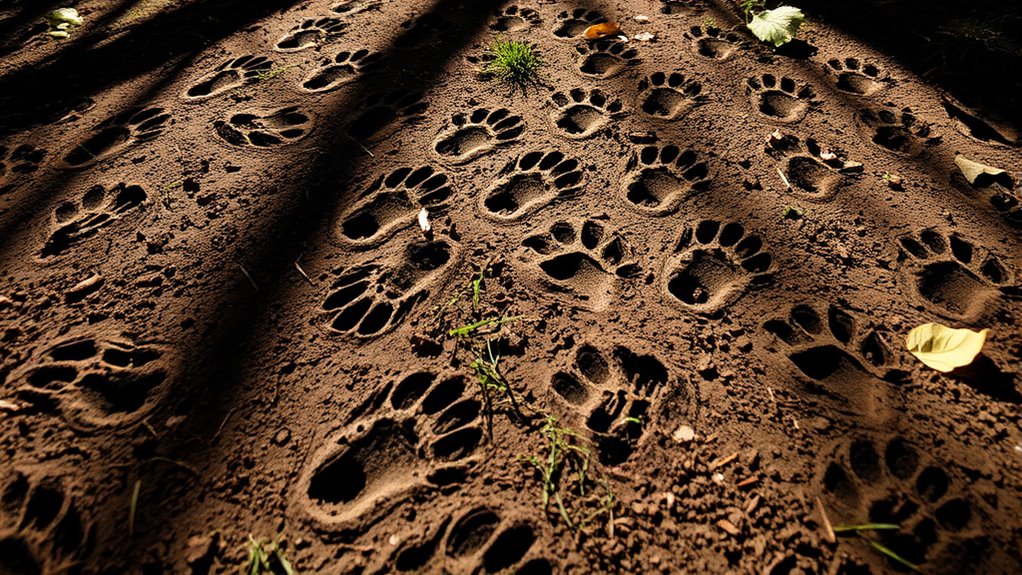Animal tracks are essential clues that reveal wildlife behavior, habits, and presence in an ecosystem. By observing tracks, you can analyze animal movement, feeding patterns, and social interactions. Recognizing unique characteristics like depths, shapes, and arrangements lets you identify species and their health. These insights enhance your understanding of biodiversity and ecosystem relationships. Plus, tracking can be a strategic tool for conservation efforts. Discover even more about how tracking influences wildlife and habitat by exploring further.
Key Takeaways
- Animal tracks provide insights into species identification, including age and health, enhancing ecological understanding.
- Analyzing tracks reveals feeding habits and social behaviors, contributing to wildlife management and conservation efforts.
- Tracking helps anticipate animal movements, facilitating protective measures against human-wildlife conflicts.
- Spoor detection aids in monitoring populations and identifying critical habitats for conservation initiatives.
- Collaboration among trackers enhances knowledge sharing, improving techniques and increasing tracking efficiency in various terrains.
Tracking as an Art and Science
Tracking isn't just about following footprints; it's a blend of art and science that sharpens your observational skills. You must be able to read the subtle signs left in the environment, from tracks to scat.
This practice has historical roots in prehistoric hunting, where understanding animal movements meant survival. As you develop your skills, you'll find that interpreting these signs allows you to analyze feeding patterns and social behaviors much faster.
By merging intuition with scientific observation, you can predict animal paths and optimize your search. Whether you're on either side of a river or maneuvering through diverse terrain, effective tracking relies on your ability to revise hypotheses based on new evidence.
Embrace the art and science, and you'll deepen your connection with nature.
Understanding Animal Behavior Through Tracks

When you analyze animal tracks, you reveal essential clues about their behavior, including feeding habits and movement patterns.
By identifying scat signatures and other signs, you gain a clearer picture of what animals eat and how they interact with their environment.
Understanding these elements helps you appreciate the complex relationships within ecosystems.
Analyzing Track Patterns
Understanding animal behavior through track patterns offers valuable insights into their lives. By analyzing these tracks, you can identify species based on their unique footprints, which differ in size, shape, and stride length.
The arrangement and depth of tracks reveal movement patterns, indicating whether an animal is walking, running, or limping. This can help you assess their health and activities, like hunting or foraging.
Additionally, examining the spacing between tracks allows you to estimate the animal's speed, shedding light on its urgency or comfort in the environment. Patterns in relation to environmental features, such as water sources or feeding areas, can also predict future movements, enhancing your tracking success and understanding of their ecological role.
Identifying Scat Signatures
Scat signatures can reveal a wealth of information about an animal's behavior and diet. By examining size, shape, and content, you can gather crucial clues about the species responsible for the droppings.
Look for undigested materials like fur, bones, or seeds, which indicate feeding preferences. Different species have distinct scat patterns—carnivores typically produce tubular, segmented scat, while herbivores leave more rounded, fibrous droppings.
Environmental factors, such as moisture and temperature, affect how quickly scat decomposes, helping you estimate how recently an animal passed through an area.
Analyzing scat is essential in wildlife studies, as it not only identifies species but also offers insights into population dynamics and ecosystem health, enhancing your understanding of local wildlife.
Understanding Feeding Habits
How can animal tracks enhance your knowledge of feeding habits? By examining tracks, you can reveal essential insights into an animal's diet and behavior.
Look closely at the terrain around the tracks, and you might find evidence of their feeding preferences.
- Tracks near waterholes hint at hydration habits and food availability.
- Scat reveals what animals consume, from fruits to small prey.
- The size and depth of tracks indicate the animal's weight and dietary needs.
- Observing the direction of tracks helps identify migration routes and seasonal foraging patterns.
Recognizing Spoor: Signs of Animal Presence

Recognizing animal spoor is essential for anyone interested in wildlife tracking. Spoor includes various signs, such as tracks, scat, feathers, and kills, each offering crucial insights into an animal's behavior and ecology.
When you identify tracks, pay attention to their unique shapes and sizes; these clues can reveal the species, age, and condition of the animal. Analyzing scat helps you understand dietary habits and health, while also pinpointing territory locations.
Don't overlook feathers, nibbled vegetation, or fur left behind; these signs can indicate specific activities or behaviors in the area. With keen observation skills and knowledge of your environment, you'll differentiate between signs of various species, enhancing your understanding of their interactions within the ecosystem.
Anticipation and Prediction in Tracking

Anticipating an animal's next move is essential for effective tracking. By mentally positioning yourself as the animal, you can predict its movement patterns based on environmental cues.
Look for obvious locations where animals are likely to leave signs, such as:
- Narrow openings between dense bushes
- Well-worn paths through the grass
- Freshly disturbed soil near feeding areas
- Hidden spots near water sources
Understanding their feeding habits and natural behaviors helps you follow likely routes, minimizing unnecessary searching.
As you gather new information, continuously revise your hypotheses about their movements. This practice enhances your efficiency and accuracy, allowing you to locate tracks and signs more effectively.
With keen anticipation, you'll become a more skilled tracker, reducing the time spent on the hunt.
The Role of Stealth in Successful Tracking
When you're tracking animals, mastering stealth can make all the difference.
By minimizing your movements and positioning yourself downwind, you reduce the chance of being detected.
Quiet observation practices will enhance your ability to see animal behaviors without causing alarm.
Movement Minimization Techniques
To successfully track animals, you must master the art of stealth, as even the slightest noise or scent can alert your quarry.
Slow, deliberate movements are essential for minimizing disruption and enhancing your chances of spotting tracks. Anticipate animal routes and position yourself strategically in areas like:
- Openings between dense bushes
- The edge of a forest
- Near water sources
- Paths where animal trails converge
Downwind Positioning Strategies
Positioning yourself downwind is essential for effective tracking, as it helps you avoid revealing your presence to animals that rely heavily on their sense of smell. To enhance your stealth, consider the following strategies:
| Strategy | Description | Benefits |
|---|---|---|
| Knowledge of Winds | Understand wind patterns and shifts | Stay undetected |
| Quiet Movement | Move deliberately to minimize noise | Prevent animal alertness |
| Natural Cover | Utilize trees and bushes for concealment | Blend into the environment |
Quiet Observation Practices
As you venture into the wild, mastering quiet observation practices becomes essential for successful tracking. Stealth minimizes the chances of alerting animals to your presence, preserving their natural behavior for your observation.
To achieve this, focus on:
- Moving like a shadow, avoiding rustling leaves or snapping twigs
- Positioning yourself downwind, allowing scents to drift away from your quarry
- Adopting slow, deliberate movements, giving you a better chance to spot tracks and signs
- Anticipating animal behavior by understanding their movement patterns, enhancing your ability to remain undetected
Collaborating for Effective Tracking
Collaborating with other trackers can considerably enhance your ability to discover animal tracks, as sharing insights leads to more effective strategies and quicker identification of signs. Experienced trackers can guide you in predicting animal movement patterns, saving time in challenging terrains. Working in teams allows you to cover more ground and access hard-to-reach areas, essential for detecting spoor in tough conditions.
Here's a quick reference table to illustrate collaboration benefits:
| Benefit | Description | Example |
|---|---|---|
| Knowledge Sharing | Exchange tracking techniques | Learning from seasoned trackers |
| Task Division | Covering larger areas efficiently | Splitting roles among team |
| Network Access | Connecting with professional groups | Joining the International Society of Professional Trackers |
Challenges in Spoor Detection

Detecting spoor can be incredibly challenging, especially when you're faced with hard, stony ground that obscures or damages tracks.
Environmental factors like rain or snow can erase or alter animal tracks, complicating your efforts even further. In difficult terrain, you'll often find sparse signs, pushing you to rely on your knowledge of animal behavior and anticipation.
You'll need to adjust your tracking techniques continuously, as different surfaces require different approaches.
- Sharp rocks hiding delicate prints
- Muddy patches revealing fleeting impressions
- Fallen leaves masking subtle signs
- Weathered paths whispering of unseen movement
Resources for Tracking Enthusiasts
Whether you're a seasoned tracker or just starting out, having the right resources can make all the difference in honing your skills. Key literature like *Tom Brown's Field Guide to Nature Observation and Tracking* lays a solid foundation for understanding tracking techniques and animal behavior.
For detailed illustrations and descriptions of various animal tracks, *Mammal Tracks & Sign* by Elbroch is essential. The International Society of Professional Trackers offers valuable networking opportunities and resources to help you advance your tracking skills.
Additionally, CyberTracker Conservation provides training and certification programs that deepen your tracking knowledge. Finally, research studies, such as Liebenberg's on persistence hunting, enrich your understanding of the ecological implications of tracking.
Equip yourself with these resources to enhance your tracking journey!
The Conservation Impact of Tracking
Tracking isn't just a skill for enthusiasts; it's an essential tool in wildlife conservation. By monitoring animal populations and evaluating habitat use, you can help identify critical areas for protection. This knowledge informs effective management strategies.
Consider these impacts of tracking:
- Insightful patterns in animal behavior that reduce human-wildlife conflicts.
- Rapid detection of threats like poaching, allowing for timely interventions.
- Community collaboration that fosters stewardship and raises awareness about biodiversity.
- Successful projects like rewilding and restored migratory corridors, enhancing ecosystem resilience.
Through your tracking efforts, you contribute to the preservation of endangered species and the overall health of our planet's ecosystems.
Frequently Asked Questions
Why Are Animal Tracks Important?
Animal tracks are important because they provide you with essential information about wildlife behavior and movement.
By observing tracks, you can learn which species are present in an area, their feeding habits, and their interactions with other animals.
This knowledge helps you appreciate the balance of ecosystems and can even inform conservation efforts.
Plus, tracking can enhance your outdoor experiences, connecting you to nature in a deeper and more meaningful way.
What Is the Purpose of Animal Tracking?
The purpose of animal tracking is to help you understand animal behavior and movements in their natural habitats.
By observing tracks and signs, you can gain insights into feeding patterns, habitat preferences, and migration routes. This knowledge not only enhances your wildlife observation skills but also aids in conservation efforts.
When you learn to interpret these signs, you're better equipped to protect and manage wildlife, contributing to healthier ecosystems.
Why Is It Important to Track Animal Populations?
"You can't manage what you don't measure." Tracking animal populations is essential for understanding how species interact with their environment.
By monitoring these populations, you gain insights into their behavior, migration patterns, and feeding habits. This information helps you identify critical habitats and supports effective wildlife management.
Additionally, tracking reveals shifts in populations over time, allowing you to respond to environmental changes and human impacts, ensuring that ecosystems remain healthy and balanced.
How Can Identifying Animal Tracks Help Aid in the Study of Living Things?
Identifying animal tracks helps you understand the behaviors and movements of various species. By analyzing these tracks, you can learn about their feeding habits, social interactions, and habitat use.
This knowledge aids in evaluating biodiversity and monitoring population dynamics. You'll also discover valuable insights into predator-prey relationships and ecological interactions.
Ultimately, recognizing tracks enhances your appreciation of wildlife and contributes to ongoing conservation and management efforts within ecosystems.
Conclusion
In the intricate dance of nature, tracking animal footprints reveals a world of stories waiting to be uncovered. By honing your skills in recognizing spoor and understanding animal behavior, you not only deepen your connection to the wild but also contribute to conservation efforts. Embrace the art and science of tracking; it's a powerful tool that fosters respect for wildlife and enhances your outdoor experiences. So, lace up your boots and step into the adventure that awaits!










